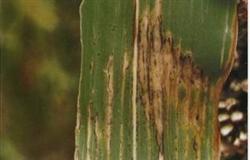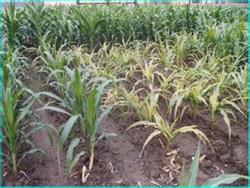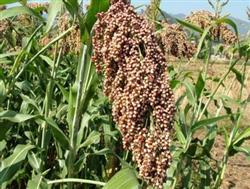Sorghum black bundle disease

Symptomatic sorghum black bundle disease is a vascular bundle disease, also known as duct bundle blackening. When the leaf is obvious, brown stripes appear on the leaf vein, and there are large necrotic spots along one or both sides of the main vein, so that the leaf and leaf sheath become purple or brown, when the leaf is dry, the stem is a little thick, and there is branching in the upper part of the diseased plant. Transverse section of the diseased stem shows that the vascular bundles, especially the xylem ducts, turn brown and are blocked. In the longitudinal section, the vascular bundles turned reddish brown or dark brown from bottom to top, and the vascular bundles of the basal internodes blackened more obviously than those of the upper internodes. Seriously diseased plants withered early, did not heading or did not bear fruit, and the yield was reduced by 50%. China is distributed in three northeastern provinces. The pathogen Acremonium stictum W.Gams is called Alternaria oryzae, which belongs to semi-known subphylum fungi. Synonym Cephalosporium acremonium Corda. The colony is round, the aerial hyphae are dense, curly, initially white, and then light pink. Conidiophores without septum, size 40-60 × 3 (um). Conidia unicellular, nearly colorless, oval, 4 × 1 um in size. In addition to harming sorghum, it can also harm many kinds of monocotyledons and dicotyledons, such as corn, soybean, wheat, oat, cotton and so on. The route of transmission and incidence conditions of the disease are carried by seeds and soil. After invading from the root of the host, the bacteria entered the vascular bundle tissue. Under natural conditions, field pathogens can also infect leaves and leaf sheaths and cause the disease through vascular bundle expansion. The disease has been reported in Egypt, Argentina, Venezuela, Mexico, Sudan, Honduras and other countries. The incidence of Tx622A and rx623A is obvious in our country. Foreign Sc35-6, Sc630-11E and GPR-148 showed disease resistance. Control methods (1) breeding disease-resistant varieties. (2) to carry out quarantine to prevent the spread of the disease.
- Prev

Sorghum downy mildew
Sorghum seedling blight-symptom sorghum can occur when it grows to 4-5 leaves. It begins with the lower leaf and expands upward. The infected leaves produce purplish red stripes and gradually unite, causing the leaves to die gradually from the top and the seeds turn brown. Sorghum seedling blight-pathogen. Fusarium oxysporum, which is called Fusarium moniliforme, is a subphylum fungus. In PDA medium.
- Next

New cultivation techniques for High yield of Sorghum
1. Timely sowing to protect the whole seedling sowing date is based on soil temperature and soil moisture. In early spring, seeds can be sown when the soil is 10 centimeters deep and the ground temperature is 12 ℃ and the water content is 15-20%. If necessary, you can first irrigate water to replenish moisture and then sow or sit in water to add moisture to sow to prevent bud drying and uneven emergence of seedlings. Liaoning is the main producing area of sorghum in Liaoning.
Related
- The first cup of black tea in spring, the flavor and history of tea gardens in Kenya, Africa
- The computer can not only choose potatoes, but also grow tea rice. AI will grow winter oolong tea champion.
- It is not only the inflated tea bitten by insects, but also engraved with the four seasons tea in Beipu.
- The Oriental Beauty Tea Festival in Zhuxian County takes the stage at the weekend to experience the plus-size feast of oil tea.
- & quot; Oriental Beauty Tea & Exploration of Emei in Hsinchu, the hometown of quot;
- The new variety of strawberry "Tainong 1" dessert is the first choice with mellow aroma. Crimson gorgeous
- History of Tea in Taiwan: from Wild Inner Mountain to Export Tea Garden
- Two types of Taiwan Oriental Beauty Black Tea won the British three-Star Award for Childhood Tea Xiang Zhang Jiaqi changed from pilot to champion tea maker.
- Banana species and varieties: the planting history of Taiwan Xianren banana and dwarf banana is long, is banana disease resistant?
- Coffee planting Technology: Qianjie Coffee from Seedling to harvesting

